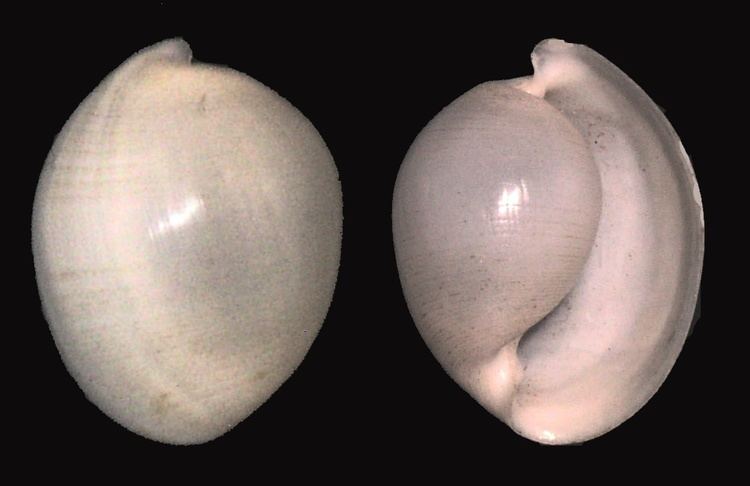Atys is a genus of very small to medium-sized sea snails, marine opisthobranch gastropod mollusks in the family Haminoeidae.
All the species within the genus Atys are herbivores. They occur in tropical and warm oceans and seas. They are cephalaspideans, part of the suborder of headshield slugs and bubble snails.
The genus was named after Atys, a king of Alba Longa, who was mentioned in ancient Greek texts.
These snails have a shell which is very lightweight and translucent, with a sunken spire. The shape of the shell in some species resembles a bubble, and because of this, species in this genus are commonly known as Atys bubble shells or Atys bubble snails. (Several other shelled families within the Cephalaspidea are even more commonly known as "bubble shells" or "bubble snails", for example, the Bullidae.)
The anatomy of the soft parts of most species within this genus has not been studied, but it seems that some of the species in this genus can not reliably be discriminated on the basis of shell characters alone. Unfortunately however, a considerable number of the species were originally named from empty shells, and as a result, their exact identity may be problematic.
Species within the genus Atys include:
Atys alayoi Espinosa, Fernandez-Garcès & Ortea, 2004Atys angustatus Smith, 1972Atys beberkiriana Martin, 1906Atys bicolor Bozzetti, 2009Atys blainvilliana Récluz, 1843 (nomen dubium - probably a synonym of Atys jeffreysi)Distribution : Mediterranean, TurkeyAtys brocchii Michelotti, 1847Distribution : Mediterranean, TurkeyAtys caribaeus d'Orbigny, 1841 Also known as Caribbean glassy-bubble, Sharp’s paper-bubbleDistribution : Florida, Caribbean, Brazil, Western Atlantic Ocean.Length : 11 mmDescription : found at depths up to 183 m; small ovate white shell, narrowing toward the apex; sunken spire; body whorl has spiral grooves at the edges; narrow apertureAtys castus Carpenter, 1864 Clean glassy-bubbleDistribution : Baja California, MexicoLength : 10 mmAtys chelidon Melvill, 1912Atys cheverti Brazier, 1879Atys chimera Baker & Hanna, 1927Distribution : Baja California, MexicoLength : 7 mmAtys constrictus Habe, 1952Atys convexa Preston, 1908Atys costulosa Pease, 1869Atys curta A. Adams, 1850 Striate bubbleAtys cylindraeus (Helbling, 1779)Atys cylindrica Hinds, 1779Distribution : Indo-PacificLength : 30 mmDescription : Thin, fragile, subcylindrical shell with sunken apex. Color is white or very light brown. it may have a few brown axial lines.Atys dactylus Hedley, 1899Atys darnleyensis Brazier, 1879Atys debilis Pease, 1871Distribution : HawaiiLength : 10 mmDescription : on sandy bottoms where they burrow through the sand with their flattened headshield for food like small crustaceans.Atys dubiosa Brazier, 1879Atys ehrenbergi A. Issel, 1869 (possibly = Atys naucum)Distribution : Red SeaLength : 11 mmAtys flavovirens Melvill & Standen, 1903Atys fukuokaensis HabeDistribution: JapanAtys guildingi Sowerby II, 1869 Guildin’s atysDistribution: Mexico, Costa Rica, Panama, Venezuela, BrazilLength : 12 mmDescription : found at depths up to 25 mAtys hyalinus Watson, 1883Atys jeffreysi Weinkauff, 1868Distribution : Canary Islands, Madeira, Azores, MediterraneanAtys kekele Pilsbry, 1920Atys kuhnsi Pilsbry, 1917Atys liriope Hertlein & Strong, 1951Distribution : California, MexicoLength : 10 mmAtys lithiensis Sturany, 1903Atys macandrawii E. A. Smith, 1872Distribution : Caribbean, Brazil, Eastern Atlantic Ocean, Azores, Canaries, Cape Verde IslandsLength : 7.3 mmDescription : found at depths of up to 75 mAtys mirandae Smith, 1872Atys multistriata Schepman, 1913Distribution : Micronesia, PhilippinesLength : 12 mmDescription : short headshield, broadened anteriorly, with internal black eyes. Short posterior lobes. Triangulate parapodia cover the anterior of the shell; short, rounded tail; The translucent Hancock’s organs appear as a thin low profile ridge. Translucent white animal with brown spots and clusters of opaque white dots; thin, elongate, ovoid shell; inner margin of the outer lip extends above the apex; slightly curved columella; deep umbilicus behind the foldAtys muscaria Gould, 1859Atys naucum Linnaeus, 1758 White nut sheath bubble, Pacific nut sheath bubbleDistribution : Indo-Pacific (excluding the Red Sea), AustraliaLength : 22–50 mmDescription : common species; light brown inflated bubble shell;: the brown color comes from the periostracum, covering the shell; this flakes off when the snail dies; juveniles have lengthwise brown wavy lines on the shell.Atys neglectus Preston, 1908 *Atys nonscriptus Clean-slate glassy-bubbleAtys obscuratus Dall, 1896 Obscure glassy-bubbleDistribution : North CarolinaLength : 4 mmAtys okamotoi Habe, 1952Atys pacei Preston, 1908Atys palmarum Hedley, 1912Atys porcellana Gould, 1859Atys pransa Hedley, 1904Atys pulchra Brazier, 1879Atys reliquua Iredale, 1936Atys riiseanus Mörch, 1875Distribution : Florida, Caribbean, BrazilLength : 13 mmDescription : found at depths up to 90 mAtys sandersoni Dall, 1881Distribution : North Carolina, Cuba, Pnama, BrazilLength : 8 mmAtys scrobiculata A. Adams, 1862Atys semistriata Pease, 1860 Variably banded atys, variable banded bubbleDistribution : West PacificLength : 6 mmAtys submalleata Smith, 1904Atys supracancellata Schepman, 1913: synonym of Sabatia supracancellata (Schepman, 1913)Atys vixumbilicata Preston, 1908Atys xarifae Marcus, 1959
